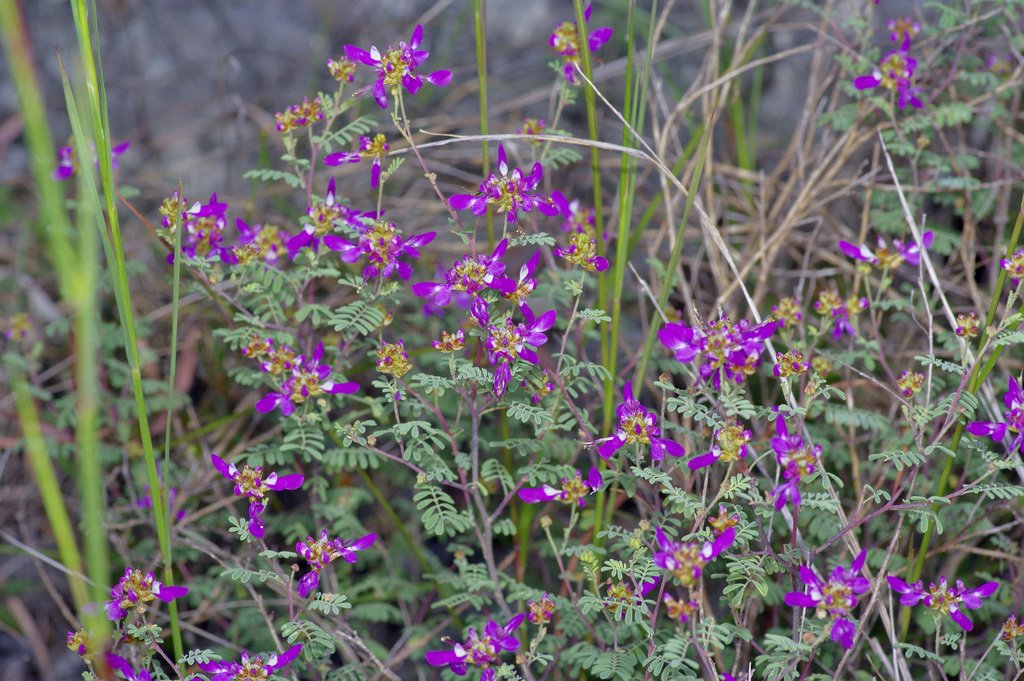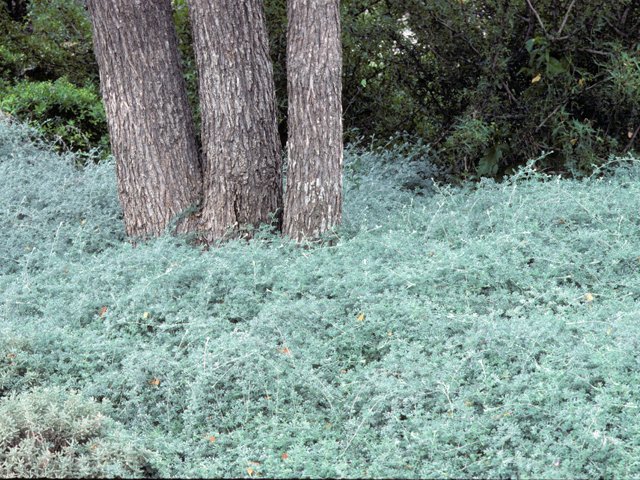The Genus Dalea
Prairie Clovers and Indigo Bushes
Family: Fabaceae
This is a large genus of about 205 species commonly known as prairie clovers or indigo bushes. They are native to the Western hemisphere, where they are distributed from Canada to Argentina. Nearly half of the known species are endemic to Mexico.
Photo of Dalea versicolor by Sky Jacobs, SEINET
Dalea bicolor
Silver Prairie Clover
Large semi-evergreen shrub (deciduous shrub in cold winter locations). Often cut back like a red bird of paradise (Caesalpinia pulcherrima). Many varieties grow about 3-4’ tall and wide, but some grow 6-8’ tall if unpruned. Magenta, to purple, to almost blue pea-shaped flowers occur in Fall through the cool season. Sometimes in spring. Some selections/varieties have greener foliage.
There are 5 varieties:
Dalea bicolor var. bicolor has the greenest foliage
The selection ‘Monterrey Blue TM’ (a selection of var. bicolor) has blueish flowers.
D. bicolor var. argyrea has the most silver foliage
D. bicolor var. orcuttiana has the most fragrant foliage.
D. bicolor var. naviculifolia is a Oaxacan endemic, not found in the trade
D. bicolor var. canescens is found in Vera Cruz and also Oaxaca, not found in the trade
Full sun, moderate to low water when established. These plants are hardy to 10°F. Cut back as needed.
The flowers are especially nectar-rich for bees, butterflies, and other pollinators. Daleas are larval food plants for the Reakirt’s blue (Echinargus isola), southern dogface (Zerene cesonia), and the gray hairstreak (Strymon melinus).
The plant is often made into a tea in Mexico.
Dalea is named for Samuel Dale an English naturalist and physician notable for his work in the natural sciences and his authorship of the Pharmacologia seu Manuductio ad Materiam Medicam in 1693. The species bicolor refers to the often two-colored flowers (usually purple or magenta, and white.
Occurs in New Mexico and Texas, south throughout much of Mexico in desert or thornscrub, on rocky or limestone soils.
Dalea capitata
Lemon Dalea
Subshrub/groundcover growing to a foot or less high, spreading to 3-5+ feet or more. Evergreen in lower elevations, may go dormant in cold locations. Foliage is fragrant. Flowers occur anytime in the warm season. Because of its low-growing, spreading nature, this plant is often used as a groundcover.
Plant in full sun, moderate water, hardy to 0°F.
The flowers are especially nectar-rich for bees, butterflies, and other pollinators. Daleas are larval food plants for the Reakirt’s blue (Echinargus isola), southern dogface (Zerene cesonia), and the gray hairstreak (Strymon melinus).
The foliage is made into tea.
Dalea is named for Samuel Dale an English naturalist and physician notable for his work in the natural sciences and his authorship of the Pharmacologia seu Manuductio ad Materiam Medicam in 1693. The specific epithet, capitata, derives from the Latin, caput/capitis, meaning "head" and hence describes the plant as having its flowers arranged in tightly compacted, head-like inflorescences.
From Central Mexico. Dalea capitata on iNaturalist
Photo by Mountain States Wholesale Nursery
Dalea formosa
Feather Dalea
Small semi-evergreen shrub growing to about 2x2’. Purple flowers anytime spring through fall, usually heaviest in spring.
Full sun is best, with moderate water and good drainage, hardy to 0°F.
The flowers are especially nectar-rich for bees, butterflies, and other pollinators. Daleas are larval food plants for the Reakirt’s blue (Echinargus isola), southern dogface (Zerene cesonia), and the gray hairstreak (Strymon melinus).
Medicinally used as an emetic, as a strengthener before a long run, and as a cathartic.
Dalea is named for Samuel Dale an English naturalist and physician notable for his work in the natural sciences and his authorship of the Pharmacologia seu Manuductio ad Materiam Medicam in 1693. The species name formosa means finely formed, handsome, or beautiful.
Found on gravelly or rocky, dry slopes from 2,000-6,500 ft. in Arizona, New Mexico, Texas, southern Oklahoma; south into northern Mexico.
Dalea frutescens
Black Dalea
Shrubby plant, semi-evergreen, growing to about 3x3’. Flowers occur anytime during the warm season.
Full sun, moderate water, hardy to 15°F. Prune back to encourage bushy growth.
The flowers are especially nectar-rich for bees, butterflies, and other pollinators. Daleas are larval food plants for the Reakirt’s blue (Echinargus isola), southern dogface (Zerene cesonia), and the gray hairstreak (Strymon melinus).
Dalea is named for Samuel Dale an English naturalist and physician notable for his work in the natural sciences and his authorship of the Pharmacologia seu Manuductio ad Materiam Medicam in 1693. The species frutescens means shrubby, or somewhat or becoming shrubby or woody.
Dry, scrubby, limestone hills in New Mexico, Oklahoma, and Texas, into northern Mexico.
Dalea greggii
Trailing Indigo Bush
This is a sprawling shrubby groundcover that can spread quite a distance as it reroots as it grows. Typically one plant can spread 6 feet wide. Normally they are only a foot or two high, but can grow taller in areas where they are being pruned on the sides. Sporadic flowers in spring and summer. Not as prolific a bloomer as the other Daleas, but an excellent groundcover.
This plant can take full sun or even grow in the shade of trees overhead. Provide moderate water, hardy to 15°F.
The flowers are especially nectar-rich for bees, butterflies, and other pollinators. Daleas are larval food plants for the Reakirt’s blue (Echinargus isola), southern dogface (Zerene cesonia), and the gray hairstreak (Strymon melinus).
Dalea is named for Samuel Dale an English naturalist and physician notable for his work in the natural sciences and his authorship of the Pharmacologia seu Manuductio ad Materiam Medicam in 1693. The specific epithet greggii refers to Josiah Gregg, a 19th-century author, explorer, and amateur naturalist of the American Southwest and northern Mexico.
New Mexico, Texas and south into northern Mexico on rocky, limestone hills in the Chihuahuan Desert, 2000-5000 ft.
Photo by Sally and Andy Wasowski
Dalea lutea
Golden Dalea
Evergreen shrub in the low desert, semi-deciduous in colder places, 6x6’.
Plant in full to part sun, moderate water, hardy to 15°F.
Heaviest bloom in the fall but can bloom anytime in the warm season. The flowers are especially nectar-rich for bees, butterflies, and other pollinators. Daleas are larval food plants for the Reakirt’s blue (Echinargus isola), southern dogface (Zerene cesonia), and the gray hairstreak (Strymon melinus).
Dalea is named for Samuel Dale an English naturalist and physician notable for his work in the natural sciences and his authorship of the Pharmacologia seu Manuductio ad Materiam Medicam in 1693.The species epitaph from Latin luteus "yellow," referring to the flower color.
Native throughout mostly eastern Mexico, mostly in the Sierra Madre Oriental.
Photo by Mountain States Nursery
Dalea pringlei
Golden Dalea
This is a small herbaceous plant reaching about 2’x2’. In warm weather long flower spikes appear with individual flowers that are purple with bright yellow stamens. The flowers are especially nectar-rich for bees, butterflies, and other pollinators. Daleas are larval food plants for the Reakirt’s blue (Echinargus isola), southern dogface (Zerene cesonia), and the gray hairstreak (Strymon melinus).
Grow in full to part sun, and provide moderate water. Plants can tolerate fairly low temperatures (since they are native up to 5,000’) but may go dormant.
This species is native to rocky hillsides and washes with boulders in the foothills around the northeastern edges of the Sonoran Desert. It can also be found in dry soil near palms and in steep canyons, 2,500-5,000 ft. in southern Arizona, south into Sonora.
Dalea pulchra
Santa Catalina Prairie Clover
Semi-evergreen shrub growing to about 5x5’. Most years bush dalea blooms heavy in spring with mostly purple flowers protruding from fuzzy bracts.
Full sun, moderate water, hardy to 15°F.
The flowers are especially nectar-rich for bees, butterflies, and other pollinators. Daleas are larval food plants for the Reakirt’s blue (Echinargus isola), southern dogface (Zerene cesonia), and the gray hairstreak (Strymon melinus).
Dalea is named for Samuel Dale an English naturalist and physician notable for his work in the natural sciences and his authorship of the Pharmacologia seu Manuductio ad Materiam Medicam in 1693. The specific epithet (pulchra) is a Latin word meaning "beautiful", "pretty", "fine" or "lovely".
Found on gravelly or rocky hills and slopes from 2,500-5,000 ft. Ranges from southern Arizona south into Mexico to southern Sonora and east and south to San Luis Potosi.
Photo by Mountain States Nursery
Dalea purpurea
Purple Prairie Clover
Winter deciduous perennial plant with tiny rose-purple flowers in cylindrical, head-like masses. Plants form tubers underground. Plants reach up to 2’ tall when blooming, but in low desert they can often be shorter.
Full to part sun, afternoon shade in summer is not a bad idea. Moderate water when established. This plant is extremely cold hardy, to -40°F.
The flowers are especially nectar-rich for bees, butterflies, and other pollinators. Daleas are larval food plants for the Reakirt’s blue (Echinargus isola), southern dogface (Zerene cesonia), and the gray hairstreak (Strymon melinus).
The leaves are edible and good for making tea and medicines, and the roots are palatable when chewed. This species has a long history of medicinal use.
Dalea is named for Samuel Dale an English naturalist and physician notable for his work in the natural sciences and his authorship of the Pharmacologia seu Manuductio ad Materiam Medicam in 1693. The specific epithet purpurea is Latin for 'purple-red' referring to the flowers.
Found in grasslands, from 4,000-7,500 ft. It is native to central North America, where it occurs from central Canada to the southeastern and southwestern United States including southeastern Arizona, except for the east and west coasts.
Photo by Robert W Smith
Dalea versicolor var. sessilis
Weeping Dalea
Evergreen shrub reaching 3’ high, 4’ wide with pendulous, arching stems. Purple and yellow flowers in spring through fall, sometimes occurring later in the lower desert.
Full sun makes this plant looks best but it will tolerate some shade. Moderate water with good drainage, hardy to 20°F. Prune back to encourage bushiness.
The flowers are especially nectar-rich for bees, butterflies, and other pollinators. Daleas are larval food plants for the Reakirt’s blue (Echinargus isola), southern dogface (Zerene cesonia), and the gray hairstreak (Strymon melinus).
Unique phenolic metabolites of Dalea versicolor have been identified that enhance antibiotic activity against pathogenic bacteria like Staphylococcus aureus and Bacillus cereus.
This is a polymorphic species with several varieties. Our variety, sessilis, is the most commonly available variety and what is found naturally in Arizona.
Dalea is named for Samuel Dale an English naturalist and physician notable for his work in the natural sciences and his authorship of the Pharmacologia seu Manuductio ad Materiam Medicam in 1693. The species epitaph versicolor means variously colored.
Found on rocky slopes from 3,000-6,000 ft in southeastern Arizona into Mexico.











